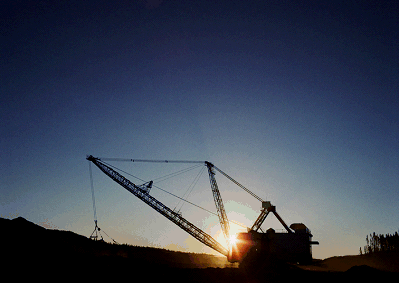|
|
|
 |
 |  |
 |  |
 |  |
WHAT IS HAPPENING IN MINING?
Petroleum Goes Up and Minerals Go Down – Both onshore and offshore petroleum exploration expenditure recorded increases during the December quarter in 2008. Expenditure for the quarter rose to $135.8 million and $877.6 million respectively, a 12.8% and 32.8% rise from the September quarter. Over the same period, expenditure on mineral exploration decreased by 5.7% to $648.5 million. These figures represent a reversal to those of September quarter 2008 in which expenditure on mineral exploration rose while expenditure on petroleum exploration decreased.
Source: ABS, Mineral and Petroleum Exploration, Australia (8412.0) |  |
 |  |
 |  |
Mining Labour Force Decreases – In the February 2009 quarter there were 171,500 people employed in the mining industry. This is a 2,400 person decrease from 173,900 employed in the previous quarter. During 2008 the mining industries employment numbers grew from 145,400 to 173,900 people. This is a dramatic change from 2007 that only had a 1,900 person variation in employment throughout the year with figures ranging from a low of 135,700 to a high of 137,600 people.
Source: ABS, Labour Force, Australia, Detailed, Quarterly (6291.0.55.003)
Income and Expenditure Remain High – The mining industry chain volume measure trend of income from sales of goods and services totalled $29,956 million at the end of the December quarter. This is a 0.6% increase from the September quarter. During the same period the chain volume measure trend of private new capital expenditures rose by 6.3% to $8,372 million from September 2008.
Source: ABS, Business Indicators, Australia, (5676.0 ), and Private New Capital Expenditure and Expected Expenditure, Australia,(5625.0 )
Australian Mineral Production - In the period 2001-02 to 2006-07 significant increases in the quantity of production were recorded for manganese ore (up 138%), liquefied natural gas (up 93%) and iron ore and concentrate (up 57%). Crude oil production declined 30% over the same period.
Significant increases in percentage terms in the value of minerals production in this period were for manganese ore (up 318%), nickel (up 313%) and iron ore and concentrate (up 205%). In dollar terms the largest increase was in iron ore and concentrate (up $10,740m), followed by black coal (up $9,843m). Significant decreases in percentage terms were recorded for bauxite and salt (both down 14%).
Source: ABS, Mining Operations, Australia 2006-07 (8415.0 ) (Final issue).
Australia’s Share of World EDR – Australia has a large percentage of some of the world’s economic demonstrated resources (EDR’s). EDR’s are proven or probable resource reserves. In 2007, Australia had 38% of the EDR for Nickel, 34% for Uranium, 30% for Lead, and 25% for Brown Coal. Other significant amounts of the world’s EDR reserves within Australia include 24% of Zinc, 17% of Silver, 17% of Industrial Diamonds, 14% of Gold, and 13% of Iron Ore.
Source: Geoscience Australia, Australia’s Identified Mineral Resources 2008, Table 1 |
 |  |
 |  |
|
 Print Page
Print Page
 Print All
Print All
 Print Page
Print Page
 Print All
Print All